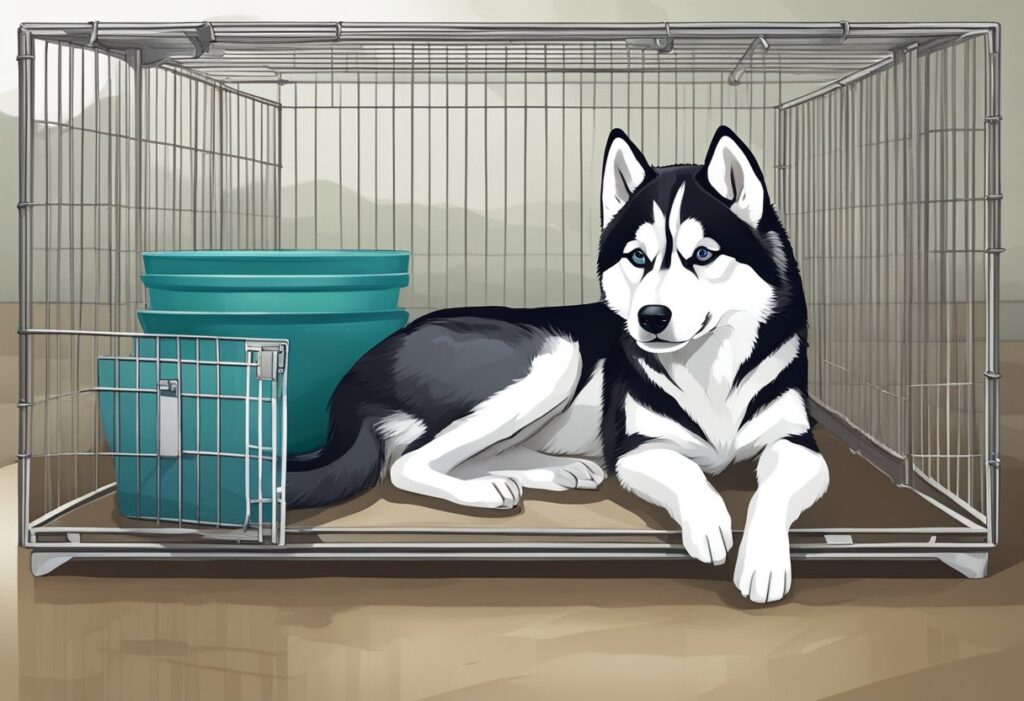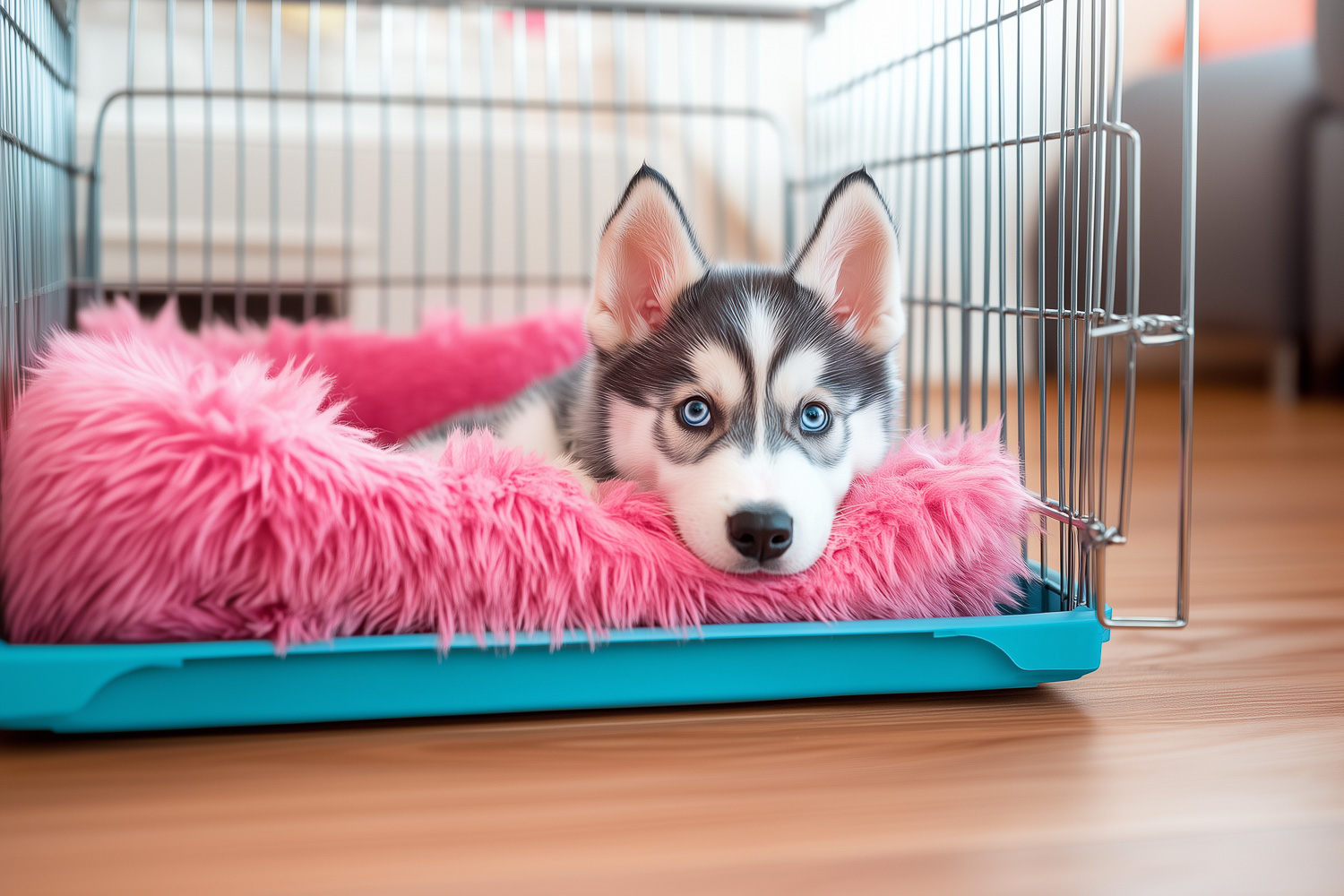Crate training a Husky can be a rewarding experience for both the dog and owner. Huskies are known for their strong-willed nature and high energy levels, which can make training a challenge. A well-planned crate training approach can help create a safe and comfortable space for your Husky while also aiding in housebreaking and reducing destructive behaviors.

Crates provide dogs with a den-like environment, tapping into their natural instincts. For Huskies, who are known escape artists, a sturdy and escape-proof crate is essential. The crate should be large enough for the dog to stand up, turn around, and lie down comfortably. Starting crate training early and using positive reinforcement techniques can help your Husky view the crate as a positive space rather than a punishment.
Patience and consistency are key when crate training a Husky. These intelligent dogs respond well to routine and clear expectations. Gradually increasing the time spent in the crate and making it a pleasant experience with treats and toys can help your Husky adjust to their new safe space.
Key Takeaways
- Crate training creates a safe space for Huskies and aids in housebreaking
- Use positive reinforcement to help your Husky view the crate as a comfortable den
- Patience and consistency are crucial for successful crate training with Huskies
Understanding Crate Training
Crate training is an essential part of raising a Husky puppy. It provides a safe space and aids in housebreaking. The right approach and proper crate selection are key to success.
Benefits of Crate Training
Crate training offers many advantages for Husky puppies. It creates a den-like environment, tapping into their natural instincts. This safe haven reduces anxiety and stress, especially when left alone. A crate helps with housebreaking by teaching bladder control. It also prevents destructive behavior when owners can’t supervise.
Crates provide a routine, which Huskies thrive on. They learn to associate their crate with rest and quiet time. This helps them settle down more easily. Crates also make travel safer and easier.
Consistency is crucial in crate training. Regular use builds positive associations. With patience, the crate becomes a comforting spot for the puppy.
Choosing the Right Crate
Selecting the proper crate is vital for effective training. Size matters – the crate should be big enough for the Husky to stand, turn around, and lie down comfortably. But it shouldn’t be too large, as this may encourage accidents.
Durability is important for Huskies, known for their strength and energy. Wire crates offer good ventilation and visibility. Plastic crates provide more privacy and are lighter for travel.
Consider the crate’s material and construction. It should be sturdy and escape-proof. Removable trays make cleaning easier. Some crates come with dividers, useful for growing puppies.
Choose a crate with a comfortable floor. Add a soft bed or blanket to make it cozy. Place the crate in a quiet area of the home, away from high traffic.
Establishing a Positive Association
Crate training a Husky requires patience and a focus on creating positive experiences. The right approach can help your Husky see their crate as a safe, comfortable space.
Introducing the Crate
Start by placing treats near the crate’s entrance. Let your Husky explore at their own pace. Don’t force them inside.
Next, toss treats just inside the crate door. Praise your Husky when they reach in to get them.
Once comfortable, encourage your Husky to step fully inside. Use a happy tone and give treats.
Keep sessions short at first – 5-10 minutes is plenty. Gradually increase time as your Husky gets more at ease.
Crate Placement and Setup
Put the crate in a quiet area of your home. Avoid high-traffic spots or noisy areas.
Make sure the crate is the right size. Your Husky should be able to stand up, turn around, and lie down comfortably.
Add soft bedding to make it cozy. A blanket or dog bed works well.
Include some safe toys. This gives your Husky something to do while in the crate.
Keep the crate door open when not in use. This lets your Husky go in and out freely.
Using High-Value Rewards
Use special treats your Husky loves. These might be small pieces of cooked chicken or cheese.
Give treats when your Husky enters the crate on their own. This builds a strong positive link.
Try stuffing a Kong toy with peanut butter. Freeze it for a longer-lasting treat.
Use verbal praise along with treats. A happy “Good dog!” can be very rewarding.
Vary the rewards to keep things interesting. Mix up different treats and toys.
Remember to stay patient. Some Huskies may take longer to warm up to their crate than others.
Developing a Crate Training Routine
A good crate training routine helps Huskies feel safe and comfortable in their crate. It combines exercise, feeding, and consistent training methods. A well-planned routine can address common issues like chewing and separation anxiety.
Exercise and Feeding Schedule
Huskies need lots of exercise. Take your Husky for a walk or run before crate time. This helps them settle down. Feed your Husky about 30 minutes before crate time. A full belly makes naps more likely.
Set regular times for meals, walks, and crate sessions. Stick to this schedule every day. Your Husky will learn when to expect crate time.
Use a chart to track your Husky’s routine:
| Time | Activity |
|---|---|
| 7 AM | Walk |
| 8 AM | Breakfast |
| 9 AM | Crate |
| 12 PM | Walk |
| 1 PM | Crate |
| 5 PM | Walk |
| 6 PM | Dinner |
| 7 PM | Play |
| 9 PM | Crate |
Crate Training Through Puppyhood
Start crate training when your Husky is a puppy. Make the crate fun with toys and treats. Leave the door open at first. Let your puppy explore.
Gradually increase crate time. Start with 5 minutes. Work up to longer periods. Always praise your puppy for going in the crate.
Puppies can’t hold their bladder for long. Take your Husky out every 2-3 hours. This helps with potty training too.
Teething puppies like to chew. Give safe chew toys in the crate. This protects the crate and soothes sore gums.
Addressing Behavioral Concerns
Some Huskies whine or bark in the crate. Don’t let them out when they do this. Wait for a quiet moment, then open the door. This teaches them that being quiet gets them out.
For stressed Huskies, try covering the crate with a blanket. This can make it feel more den-like and safe.
If your Husky has separation anxiety, practice short absences. Leave for 1 minute, then come back. Slowly increase the time you’re gone.
Never use the crate as punishment. It should always be a safe, happy place for your Husky.
Enhancing Crate Time Comfort and Security
A cozy crate setup and engaging activities help Huskies feel safe and content. Owners can create an inviting den-like space and provide mental stimulation to make crate time enjoyable.
Creating a Comfortable Den
Huskies need a secure crate that feels like a safe haven. A soft blanket or bed gives them a comfy spot to rest. Covering part of the crate with a blanket can make it feel more den-like and soothing.
Chew toys made for heavy chewers keep Huskies busy. Puzzle toys with hidden treats give them a fun challenge. These items help prevent boredom and reduce stress.
Placing the crate in a quiet area of the home limits noise and activity that could upset the dog. A crate pad that’s the right size lets the Husky stretch out comfortably.
Mental Stimulation and Play
Giving Huskies toys and puzzles in their crate keeps their minds active. Treat-dispensing toys make crate time more fun. Rotating toys regularly maintains the Husky’s interest.
Short training sessions in the crate teach good behavior. Rewarding calm actions with treats and praise builds positive feelings about the space.
Playing gentle music or leaving a TV on low volume can soothe some Huskies. A stuffed Kong toy or lick mat spreads peanut butter or wet food into a longer-lasting activity.
Regular exercise before crate time helps Huskies settle down more easily. A tired Husky is more likely to relax in the crate without getting restless.


Leave a Reply